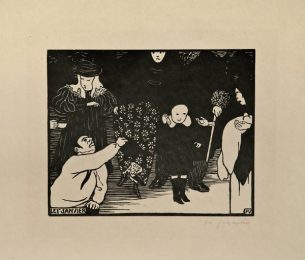Details — Click to read
Very fine, brilliant impression, with gauffrage on the dog’s coat and areas printed in gold and silver; very fine colour and condition. The background coloured cinnamon.
The Pekinese dog is dressed in a silk cape and leans against a ball decorated with patterns of coloured thread and secured by a band of cloth. This kind of dogs were not native to Japan but were introduced from China. Behind the dog is a brazier with a branch of plum blossoms. In the brazier, over the ash, there are the numbers for the long months of the year Bunsei 9 (1, 3, 4, 6, 8, 11).
At top left the poem by Ganjōtei Shirataka:
Otomego ni tenareshi mari wa iu koto o yoku kikiwakuru inu no hatsuharu
The ball is used by the little girls; it listens carefully and understands what they say, like a dog in early Spring.
Other impressions of this print are at the Metropolitan Museum of New York, at the Harvard Art Museum and at the Chester Beatty Library, Dublin (acc. n. 2018).
Literature:
Roger Keyes, The art of surimono. Privately published Japanese woodblock prints and books in the Chester Beatty Library Dublin, vol. I, pag. 164, n. 130.
In the old lunar-solar calendar of Japan the changing sequence of long and short months was established annually and necessitated the publishing of calendars. The publication and selling of this calendars was restricted to publishers who held an official license. The most essential information for practical use was of-course the length of the months and this led to a publication of abbreviated calendars which just gave this information and the corresponding zodiacal sign. The egoyomi were abbreviated calendars published without license; for this reason, the information regarding the year were in some way hidden in the design. See Matthi Forrer, Egoyomi and Surimono, Uithoorn 1979.
http://www.stanzadelborgo.it/en/scheda.php?id=125






















































